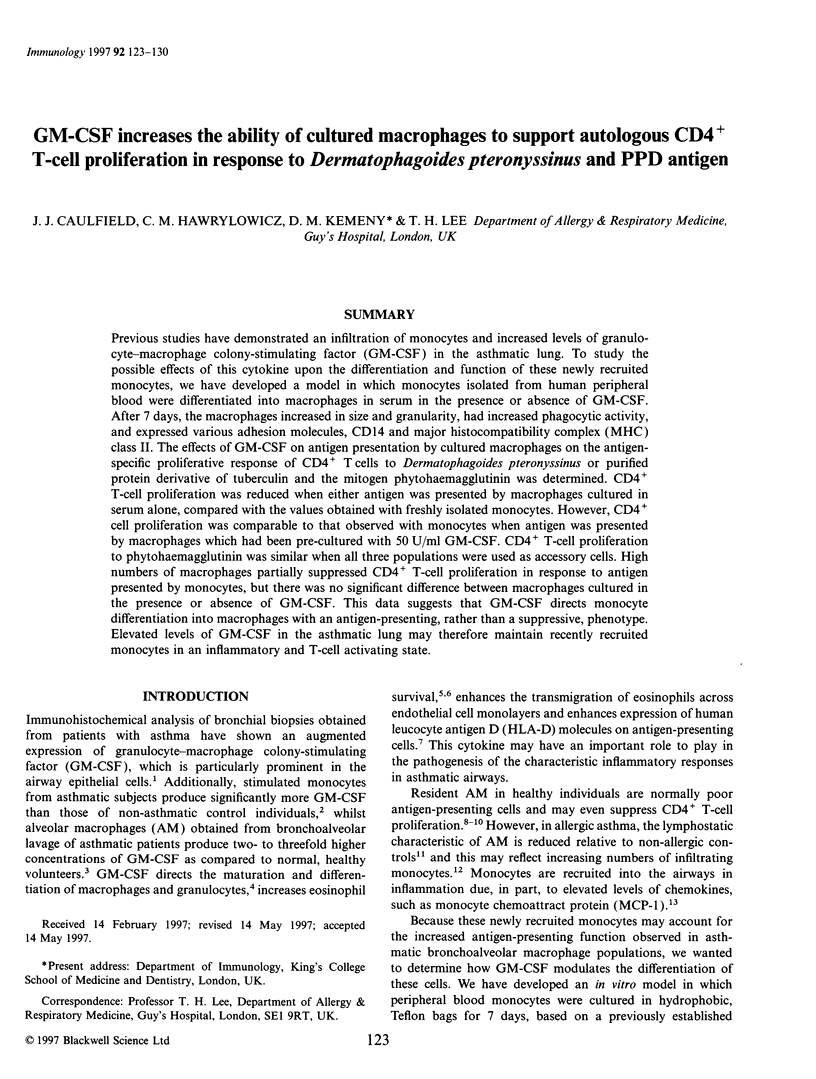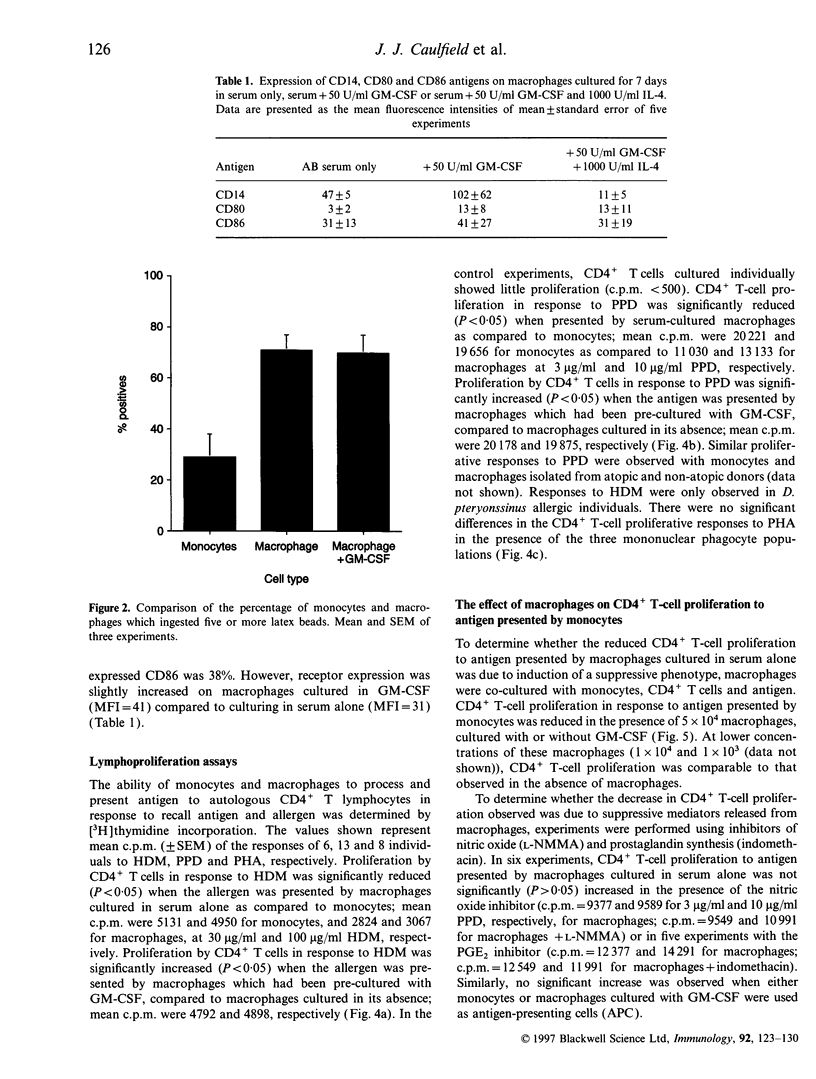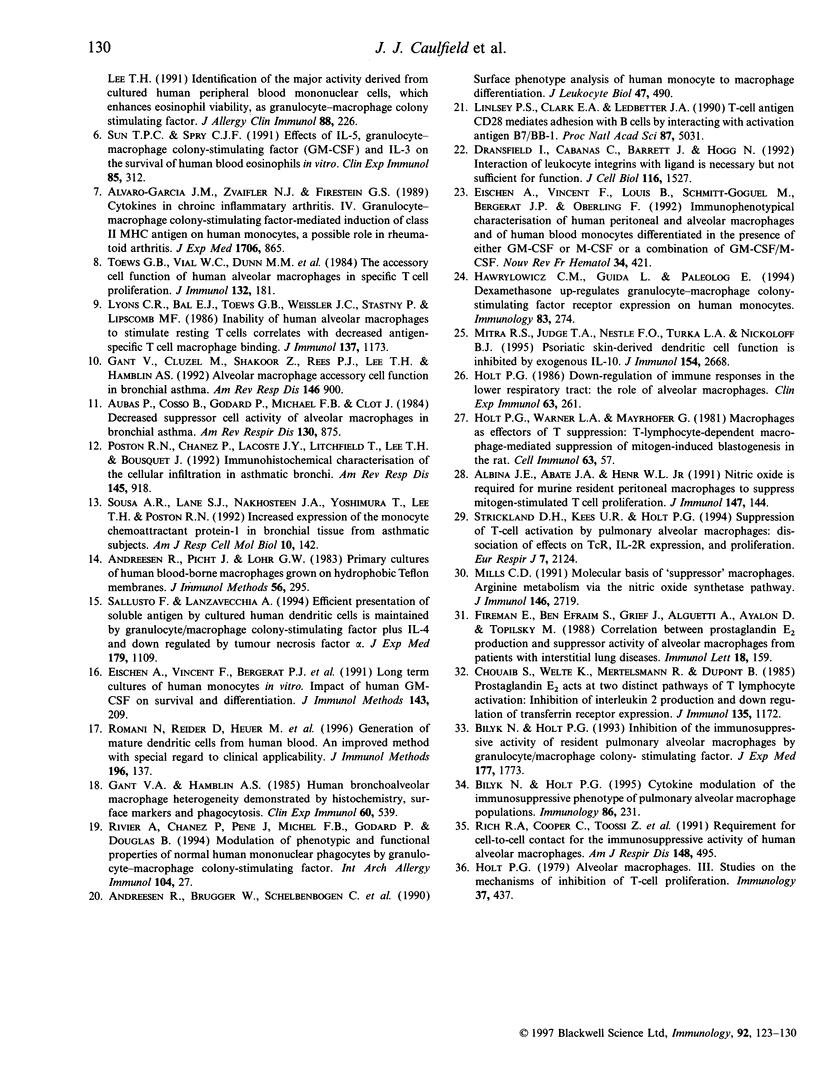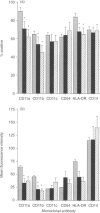Abstract
Previous studies have demonstrated an infiltration of monocytes and increased levels of granulocyte-macrophage colony-stimulating factor (GM-CSF) in the asthmatic lung. To study the possible effects of this cytokine upon the differentiation and function of these newly recruited monocytes, we have developed a model in which monocytes isolated from human peripheral blood were differentiated into macrophages in serum in the presence or absence of GM-CSF. After 7 days, the macrophages increased in size and granularity, had increased phagocytic activity, and expressed various adhesion molecules, CD14 and major histocompatibility complex (MHC) class II. The effects of GM-CSF on antigen presentation by cultured macrophages on the antigen-specific proliferative response of CD4+ T cells to Dermatophagoides pteronyssinus or purified protein derivative of tuberculin and the mitogen phytohaemagglutinin was determined. CD4+ T-cell proliferation was reduced when either antigen was presented by macrophages cultured in serum alone, compared with the values obtained with freshly isolated monocytes. However, CD4+ cell proliferation was comparable to that observed with monocytes when antigen was presented by macrophages which had been pre-cultured with 50 U/ml GM-CSF. CD4+ T-cell proliferation to phytohaemagglutinin was similar when all three populations were used as accessory cells. High numbers of macrophages partially suppressed CD4+ T-cell proliferation in response to antigen presented by monocytes, but there was no significant difference between macrophages cultured in the presence or absence of GM-CSF. This data suggests that GM-CSF directs monocyte differentiation into macrophages with an antigen-presenting, rather than a suppressive, phenotype. Elevated levels of GM-CSF in the asthmatic lung may therefore maintain recently recruited monocytes in an inflammatory and T-cell activating state.
Full text
PDF







Images in this article
Selected References
These references are in PubMed. This may not be the complete list of references from this article.
- Albina J. E., Abate J. A., Henry W. L., Jr Nitric oxide production is required for murine resident peritoneal macrophages to suppress mitogen-stimulated T cell proliferation. Role of IFN-gamma in the induction of the nitric oxide-synthesizing pathway. J Immunol. 1991 Jul 1;147(1):144–148. [PubMed] [Google Scholar]
- Alvaro-Gracia J. M., Zvaifler N. J., Firestein G. S. Cytokines in chronic inflammatory arthritis. IV. Granulocyte/macrophage colony-stimulating factor-mediated induction of class II MHC antigen on human monocytes: a possible role in rheumatoid arthritis. J Exp Med. 1989 Sep 1;170(3):865–875. doi: 10.1084/jem.170.3.865. [DOI] [PMC free article] [PubMed] [Google Scholar]
- Andreesen R., Brugger W., Scheibenbogen C., Kreutz M., Leser H. G., Rehm A., Löhr G. W. Surface phenotype analysis of human monocyte to macrophage maturation. J Leukoc Biol. 1990 Jun;47(6):490–497. doi: 10.1002/jlb.47.6.490. [DOI] [PubMed] [Google Scholar]
- Andreesen R., Picht J., Löhr G. W. Primary cultures of human blood-born macrophages grown on hydrophobic teflon membranes. J Immunol Methods. 1983 Feb 11;56(3):295–304. doi: 10.1016/s0022-1759(83)80019-2. [DOI] [PubMed] [Google Scholar]
- Aubas P., Cosso B., Godard P., Michel F. B., Clot J. Decreased suppressor cell activity of alveolar macrophages in bronchial asthma. Am Rev Respir Dis. 1984 Nov;130(5):875–878. doi: 10.1164/arrd.1984.130.5.875. [DOI] [PubMed] [Google Scholar]
- Bilyk N., Holt P. G. Cytokine modulation of the immunosuppressive phenotype of pulmonary alveolar macrophage populations. Immunology. 1995 Oct;86(2):231–237. [PMC free article] [PubMed] [Google Scholar]
- Bilyk N., Holt P. G. Inhibition of the immunosuppressive activity of resident pulmonary alveolar macrophages by granulocyte/macrophage colony-stimulating factor. J Exp Med. 1993 Jun 1;177(6):1773–1777. doi: 10.1084/jem.177.6.1773. [DOI] [PMC free article] [PubMed] [Google Scholar]
- Chouaib S., Welte K., Mertelsmann R., Dupont B. Prostaglandin E2 acts at two distinct pathways of T lymphocyte activation: inhibition of interleukin 2 production and down-regulation of transferrin receptor expression. J Immunol. 1985 Aug;135(2):1172–1179. [PubMed] [Google Scholar]
- Dransfield I., Cabañas C., Barrett J., Hogg N. Interaction of leukocyte integrins with ligand is necessary but not sufficient for function. J Cell Biol. 1992 Mar;116(6):1527–1535. doi: 10.1083/jcb.116.6.1527. [DOI] [PMC free article] [PubMed] [Google Scholar]
- Eischen A., Vincent F., Bergerat J. P., Louis B., Faradji A., Bohbot A., Oberling F. Long term cultures of human monocytes in vitro. Impact of GM-CSF on survival and differentiation. J Immunol Methods. 1991 Oct 25;143(2):209–221. doi: 10.1016/0022-1759(91)90046-i. [DOI] [PubMed] [Google Scholar]
- Eischen A., Vincent F., Louis B., Schmitt-Goguel M., Bohbot A., Bergerat J. P., Oberling F. Immunophenotypic characterisation of human peritoneal and alveolar macrophages and of human blood monocytes differentiated in the presence of either GM-CSF or M-CSF or a combination of GM-CSF/M-CSF. Nouv Rev Fr Hematol. 1992;34(6):421–434. [PubMed] [Google Scholar]
- Fireman E., Ben Efraim S., Greif J., Alguetti A., Ayalon D., Topilsky M. Correlation between PGE2 production and suppressor activity of alveolar macrophages from patients with interstitial lung diseases. Immunol Lett. 1988 Jun;18(2):159–165. doi: 10.1016/0165-2478(88)90058-2. [DOI] [PubMed] [Google Scholar]
- Gant V. A., Hamblin A. S. Human bronchoalveolar macrophage heterogeneity demonstrated by histochemistry, surface markers and phagocytosis. Clin Exp Immunol. 1985 Jun;60(3):539–545. [PMC free article] [PubMed] [Google Scholar]
- Gant V., Cluzel M., Shakoor Z., Rees P. J., Lee T. H., Hamblin A. S. Alveolar macrophage accessory cell function in bronchial asthma. Am Rev Respir Dis. 1992 Oct;146(4):900–904. doi: 10.1164/ajrccm/146.4.900. [DOI] [PubMed] [Google Scholar]
- Hallsworth M. P., Soh C. P., Lane S. J., Arm J. P., Lee T. H. Selective enhancement of GM-CSF, TNF-alpha, IL-1 beta and IL-8 production by monocytes and macrophages of asthmatic subjects. Eur Respir J. 1994 Jun;7(6):1096–1102. [PubMed] [Google Scholar]
- Hawrylowicz C. M., Guida L., Paleolog E. Dexamethasone up-regulates granulocyte-macrophage colony-stimulating factor receptor expression on human monocytes. Immunology. 1994 Oct;83(2):274–280. [PMC free article] [PubMed] [Google Scholar]
- Holt P. G. Alveolar macrophages. III. Studies on the mechanisms of inhibition of T-cell proliferation. Immunology. 1979 Jun;37(2):437–445. [PMC free article] [PubMed] [Google Scholar]
- Holt P. G. Down-regulation of immune responses in the lower respiratory tract: the role of alveolar macrophages. Clin Exp Immunol. 1986 Feb;63(2):261–270. [PMC free article] [PubMed] [Google Scholar]
- Holt P. G., Warner L. A., Mayrhofer G. Macrophages as effectors of T suppression: T-lymphocyte-dependent macrophage-mediated suppression of mitogen-induced blastogenesis in the rat. Cell Immunol. 1981 Sep 1;63(1):57–70. doi: 10.1016/0008-8749(81)90028-9. [DOI] [PubMed] [Google Scholar]
- Howell C. J., Pujol J. L., Crea A. E., Davidson R., Gearing A. J., Godard P., Lee T. H. Identification of an alveolar macrophage-derived activity in bronchial asthma that enhances leukotriene C4 generation by human eosinophils stimulated by ionophore A23187 as a granulocyte-macrophage colony-stimulating factor. Am Rev Respir Dis. 1989 Nov;140(5):1340–1347. doi: 10.1164/ajrccm/140.5.1340. [DOI] [PubMed] [Google Scholar]
- Linsley P. S., Clark E. A., Ledbetter J. A. T-cell antigen CD28 mediates adhesion with B cells by interacting with activation antigen B7/BB-1. Proc Natl Acad Sci U S A. 1990 Jul;87(13):5031–5035. doi: 10.1073/pnas.87.13.5031. [DOI] [PMC free article] [PubMed] [Google Scholar]
- Lyons C. R., Ball E. J., Toews G. B., Weissler J. C., Stastny P., Lipscomb M. F. Inability of human alveolar macrophages to stimulate resting T cells correlates with decreased antigen-specific T cell-macrophage binding. J Immunol. 1986 Aug 15;137(4):1173–1180. [PubMed] [Google Scholar]
- Metcalf D. The granulocyte-macrophage colony-stimulating factors. Science. 1985 Jul 5;229(4708):16–22. doi: 10.1126/science.2990035. [DOI] [PubMed] [Google Scholar]
- Mills C. D. Molecular basis of "suppressor" macrophages. Arginine metabolism via the nitric oxide synthetase pathway. J Immunol. 1991 Apr 15;146(8):2719–2723. [PubMed] [Google Scholar]
- Mitra R. S., Judge T. A., Nestle F. O., Turka L. A., Nickoloff B. J. Psoriatic skin-derived dendritic cell function is inhibited by exogenous IL-10. Differential modulation of B7-1 (CD80) and B7-2 (CD86) expression. J Immunol. 1995 Mar 15;154(6):2668–2677. [PubMed] [Google Scholar]
- Poston R. N., Chanez P., Lacoste J. Y., Litchfield T., Lee T. H., Bousquet J. Immunohistochemical characterization of the cellular infiltration in asthmatic bronchi. Am Rev Respir Dis. 1992 Apr;145(4 Pt 1):918–921. doi: 10.1164/ajrccm/145.4_Pt_1.918. [DOI] [PubMed] [Google Scholar]
- Rivier A., Chanez P., Pène J., Michel F. B., Godard P., Dugas B., Bousquet J. Modulation of phenotypic and functional properties of normal human mononuclear phagocytes by granulocyte-macrophage colony-stimulating factor. Int Arch Allergy Immunol. 1994 May;104(1):27–32. doi: 10.1159/000236705. [DOI] [PubMed] [Google Scholar]
- Romani N., Reider D., Heuer M., Ebner S., Kämpgen E., Eibl B., Niederwieser D., Schuler G. Generation of mature dendritic cells from human blood. An improved method with special regard to clinical applicability. J Immunol Methods. 1996 Sep 27;196(2):137–151. doi: 10.1016/0022-1759(96)00078-6. [DOI] [PubMed] [Google Scholar]
- Sallusto F., Lanzavecchia A. Efficient presentation of soluble antigen by cultured human dendritic cells is maintained by granulocyte/macrophage colony-stimulating factor plus interleukin 4 and downregulated by tumor necrosis factor alpha. J Exp Med. 1994 Apr 1;179(4):1109–1118. doi: 10.1084/jem.179.4.1109. [DOI] [PMC free article] [PubMed] [Google Scholar]
- Sousa A. R., Lane S. J., Nakhosteen J. A., Yoshimura T., Lee T. H., Poston R. N. Increased expression of the monocyte chemoattractant protein-1 in bronchial tissue from asthmatic subjects. Am J Respir Cell Mol Biol. 1994 Feb;10(2):142–147. doi: 10.1165/ajrcmb.10.2.8110469. [DOI] [PubMed] [Google Scholar]
- Sousa A. R., Poston R. N., Lane S. J., Nakhosteen J. A., Lee T. H. Detection of GM-CSF in asthmatic bronchial epithelium and decrease by inhaled corticosteroids. Am Rev Respir Dis. 1993 Jun;147(6 Pt 1):1557–1561. doi: 10.1164/ajrccm/147.6_Pt_1.1557. [DOI] [PubMed] [Google Scholar]
- Strickland D. H., Kees U. R., Holt P. G. Suppression of T-cell activation by pulmonary alveolar macrophages: dissociation of effects on TcR, IL-2R expression, and proliferation. Eur Respir J. 1994 Dec;7(12):2124–2130. doi: 10.1183/09031936.94.07122124. [DOI] [PubMed] [Google Scholar]
- Tai P. C., Sun L., Spry C. J. Effects of IL-5, granulocyte/macrophage colony-stimulating factor (GM-CSF) and IL-3 on the survival of human blood eosinophils in vitro. Clin Exp Immunol. 1991 Aug;85(2):312–316. doi: 10.1111/j.1365-2249.1991.tb05725.x. [DOI] [PMC free article] [PubMed] [Google Scholar]
- Toews G. B., Vial W. C., Dunn M. M., Guzzetta P., Nunez G., Stastny P., Lipscomb M. F. The accessory cell function of human alveolar macrophages in specific T cell proliferation. J Immunol. 1984 Jan;132(1):181–186. [PubMed] [Google Scholar]




